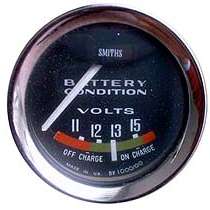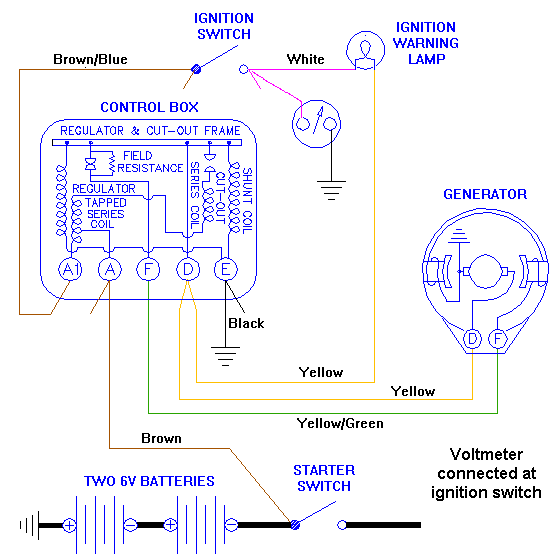The MGA With An Attitude
In-Car VOLT METER -- ET-220
 Beware first that Volt and Amp meters are substantially different critters to be used for different purposes. It used to be common to install an amp meter in an MGA (back in the day), but unless you are in search of some unusual information you may be better served with a volt meter.
Beware first that Volt and Amp meters are substantially different critters to be used for different purposes. It used to be common to install an amp meter in an MGA (back in the day), but unless you are in search of some unusual information you may be better served with a volt meter.
A dash mounted volt meter will be used to monitor electrical system voltage as you drive. The car battery tends to dampen system voltage swings, generally well within a range of 8 to 16 volts (for a nominal 12 volt system). So to have the best meter reading you would want a dash mounted volt meter with dial range of 8 to 16 volts (give or take a bit), not a 0 to 20 volt meter.

The volt meter is a high resistance low current device which can be connected directly across the battery. In practice you can connect the earth side of the volt meter to any convenient chassis ground point. It is a good idea to connect the signal side of the volt meter to a circuit which is switched by the ignition switch, so it will be disconnected from the battery when the car is parked. It is convient to connect it to the output side of the ignition switch.
Connect the volt meter + and - terminals to battery + and - respectively. If you get it wrong the meter will peg on zero with power on. When correct it read near mid scale, hopefully a bit above 12 volts with engine running. When you blow the horn it will dip just slightly lower. When you crank the engine for starting expect the battery voltage to drop noticeably lower (hopefully not below 10 volts).
You could otherwise connect the volt meter closer to the main battery cable for a lttle better reading of actual battery charging or discharging condition. When using a generator with external voltage regulator you could connect the volt meter at the point where the dynamo output wire connects to the control box. This will be intimately close to the heavy battery supply wire, but will be switched off of the battery circuit when parked (by the control box cut-out relay). Making this meter connection away from the ignition switch (or fuse box) can reduce meter fluctuations caused by small momentary current draws, such as the ticking fuel pump. However, if the dynamo output should fail, the control box cut-out relay will disconnect the "D" terminal from the battery, and the volt meter would no longer be reading battery voltage.
Open circuit voltage for a fully charged "12 volt" lead acid battery is actually 12.6 volts (2.1 volts per cell). Two 6 volt batteries in series is functionally equivalent to a single 12 volt battery. When viewing the volt meter, a reading less than 12.6 volts would indicate either a somewhat discharged battery or a discharging condition (power being taken out of the battery). A reading greater than 12.6 volts would indicate a charging condition (power being put into the battery). If the battery happens to be significantly discharged, then the volt meter could read a little less than 12 volts even when charging.
When you first switch on the ignition you can turn off all lights and accessories so the only power draw is for the ignition coil and fuel pump. You may see the volt meter fluctuate slightly with the ticking of the fuel pump. Once the carburetors are filled the (original type) fuel pump should stop ticking, at which time the remaining current draw for the ignition coil is about 4 amps (relatively small power draw), and the volt meter should read slightly more than 12 volts. If you switch on the headlights before starting the engine, and maybe some other accessories as well, you will see the voltage drop some. Hopefully it will not go much below 12 volts if the battery is in good condition. A drop to 11 volts or less would indicate a somewhat discharged battery, or a battery in poor condition which may not hold a full charge or may not be capable of putting out sufficient current for cranking the cold engine.
Switching off lights and accessories and starting the engine, the voltage should rise with generator output. The generator may not have much output near idle speed, so the system voltage my hover near 12 volts at idle. Switching on headlights may again drive it slightly below 12 volts (at idle). With no lights on, increasing engine speed should show increase of voltage with increasing dynamo output. By 2000 to 2500 RPM engine speed the voltage regulator should take over to stabilize the dynamo output, probably not in excess of 14.5 volts on the meter (although it could be slightly higher directly on the dynamo output terminal). Higher engine speed should not produce higher volt readings. If the voltage goes above 15 volts on the meter there is probably something wrong with the control box. If the volt meter remains near 12 volts with increasing engine speed (and no large electrical load), then there is something wrong with the charging circuit. Time to be checking generator and control box function.
Keep in mind that the MGA generator has a functional limit of about 22 amps maximum output. If you switch the headlights on to high beams, turn on the heater blower and windscreen wipers, and put your foot on the brake pedal to illuminate the brake lights, the vehicle total current draw may be very close to the output capacity of the generator. In this case you will see a commensurate drop in system voltage such that even at higher engine speed the volt meter may hover near the magic 12.6 volt level. When all of the dynamo output is being consumed by the lights and accessories there is no current left for charging the battery. If the battery is fully charged to begin with, then you may continue to drive in this condition almost indefinitely with no problem. If the battery was for any reason somewhat discharged to begin with, it may stay in that condition for a while, but you may still continue to drive.
If perchance you add more lights or accessories to the vehicle, such as high power driving lights or a modern radio with high output amplifier, the total power consumption may exceed the generator output. When that happens the marginally excess power required will be drawn from the battery. With this slight discharging condition you will see the voltage drop below 12.6 volts, possibly to 12 volts or slightly lower, depending on the total power draw. If you continue to drive with this condition the battery will eventually be discharged (causing the voltage to drop even more). The length of time you can get away with this depends on the battery storage capacity and the amount of current being drawn from the battery. If the headlights start to go dim you had best be switching off some high power devices, or be looking for a service station where you might get the battery recharged. If the volt meter goes below 10 volts the battery would be quite low on charge, and you can worry now, not after the engine dies for lack of spark. If you intend to do this regularly, you might consider switching to an alternator to have more charging capacity.
Additionally the volt meter can give you indication of the state of charge of the battery. Switch off all lights and accessories, switch off the engine, and switch on the key without starting the engine. If the volt meter reads 12 volts or more the battery is near full charge. If the volt meter is showing much less than 12 volts, then either the battery is somewhat discharged, or the battery is failing and in need of replacement.
|